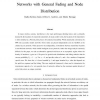Free Online Productivity Tools
i2Speak
i2Symbol
i2OCR
iTex2Img
iWeb2Print
iWeb2Shot
i2Type
iPdf2Split
iPdf2Merge
i2Bopomofo
i2Arabic
i2Style
i2Image
i2PDF
iLatex2Rtf
Sci2ools
CORR
2010
Springer
2010
Springer
High-SIR Transmission Capacity of Wireless Networks with General Fading and Node Distribution
In many wireless systems, interference is the main performance-limiting factor, and is primarily dictated by the locations of concurrent transmitters. In many earlier works, the locations of the transmitters is often modeled as a Poisson point process for analytical tractability. While analytically convenient, the PPP only accurately models networks whose nodes are placed independently and use ALOHA as the channel access protocol, which preserves the independence. Correlations between transmitter locations in non-Poisson networks, which model intelligent access protocols, makes the outage analysis extremely difficult. In this paper, we take an alternative approach and focus on an asymptotic regime where the density of interferers goes to 0. We prove for general node distributions and fading statistics that the success probability Ps 1 for 0, and provide values of and for a number of important special cases. We show that is lower bounded by 1 and upper bounded by a value that de...
| Added | 09 Dec 2010 |
| Updated | 09 Dec 2010 |
| Type | Journal |
| Year | 2010 |
| Where | CORR |
| Authors | Radha Krishna Ganti, Jeffrey G. Andrews, Martin Haenggi |
Comments (0)

